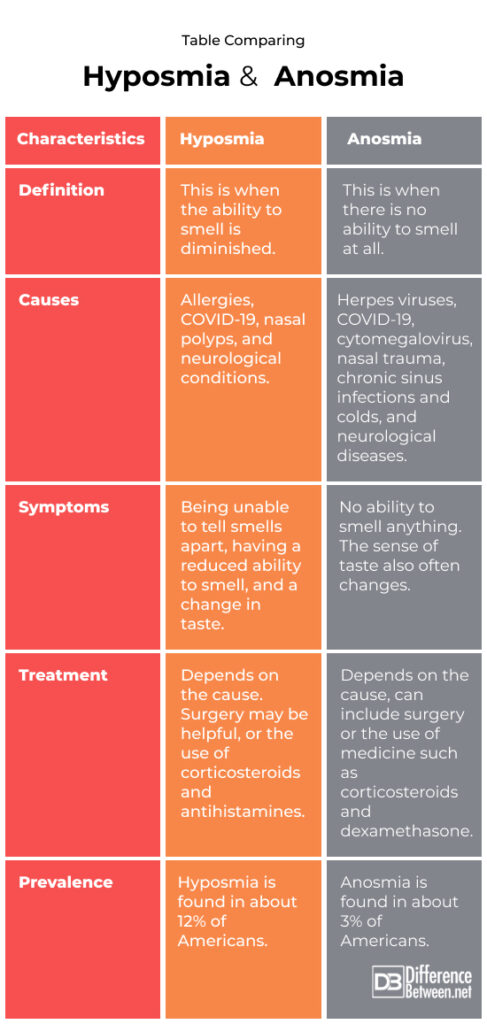Difference Between Hyposmia and Anosmia
Hyposmia is when your ability to smell is decreased and abnormal. Anosmia is when you have totally lost your ability to smell anything.

What is Hyposmia?
Definition:
Hyposmia is when your ability to smell is greatly decreased. This can also affect your sense of taste since both senses are linked.
Causes:
There are several potential causes of hyposmia including structural problems in the nose and several other medical conditions. Structural problems that can hinder your ability to smell include the presence of nasal polyps. Besides polyps, other causes include allergies, hormonal problems, COVID-19, diabetes, and neurological issues like dementia, Alzheimer’s disease, and Parkinson’s disease.
Symptoms:
The symptoms of hyposmia include having problems telling different odors apart and having a reduced sense of smell in general. Along with these signs, the person may notice a change in the sense of taste as well.
Diagnosis:
Diagnosis is by taking a medical history and completing a physical exam, and a scratch-and-sniff test. An ear, nose, and throat doctor can help with diagnosis. Imaging such as MRI scans may be done if a brain problem is suspected.
Treatment:
The treatment varies based on what the cause of the hyposmia is. In the case of structural issues, such as nasal polyps, surgery can be done. If an allergy is suspected then doctors may prescribe an antihistamine and steroid medicines.

What is Anosmia?
Definition:
Anosmia is the medical problem where a person cannot smell at all.
Causes:
There are several reasons a person may develop anosmia. Sometimes the problem is due to chronic sinusitis, a cold, or the presence of polyps in the nose. There are specific viral infections that can cause anosmia. These include the following viruses: COVID-19, herpes zoster, cytomegalovirus, and herpes simplex. Neurological diseases like Parkinson’s and Alzheimer’s may result in anosmia as can injury to the nose and the nerve that carries the signal to the brain.
Symptoms:
A person who has anosmia is unable to detect odors in their environment. Their ability to taste is also affected because taste and smell are closely connected.
Diagnosis:
Diagnosis is done by specialist doctors, ENT doctors. They will complete a physical exam and also imaging to check for potential reasons why you cannot smell.
Treatment:
Treatment may help if you have an inflammatory condition or polyps that are removed. However, it depends on the cause of the condition. People with viral infections may or may not get their sense of smell back once they recover. Researchers suggest that dexamethasone and corticosteroid nasal sprays can help COVID-19 patients to recover their sense of smell.
Difference between Hyposmia and Anosmia?
Definition
Hyposmia is when the ability to smell is reduced. Anosmia is when there is no ability to smell.
Causes
The causes of hyposmia include the following: allergies, COVID-19, nasal polyps, and neurological conditions. The causes of anosmia include the following: herpes viruses, COVID-19, cytomegalovirus, nasal trauma, chronic sinus infections and colds, and neurological diseases.
Symptoms
The symptoms of hyposmia are an inability to tell smells apart, having a reduced ability to smell, and a change in taste. The symptoms of anosmia include not being able to smell anything and noticing that things taste differently.
Treatment
The treatment options for hyposmia depends on the cause; sometimes surgery may be helpful, or the use of corticosteroids and antihistamines. The treatment options for anosmia depends on the cause, and may include surgery or the use of corticosteroids and dexamethasone.
Prevalence
Hyposmia is more common with an occurrence in about 12% of Americans. Anosmia is rarer with an occurrence in about 3% of people.
Table comparing Hyposmia and Anosmia

Summary of Hyposmia Vs. Anosmia
- Hyposmia is a decreased ability to smell.
- Anosmia is when there is no sense of smell present.
- Hyposmia and anosmia can both be caused by viral infections.
- Treatment options for both conditions depend on the causes but corticosteroids can sometimes help if there is inflammation present.
FAQ
What is hyposmia to anosmia?
Hyposmia means you have a diminished sense of smell while anosmia is a total loss of the sense of smell.
How do you know if you have hyposmia?
You may find it is difficult to tell smells apart but seeing a doctor and having a scratch-and-sniff test is the best way to assess if you have hyposmia.
What is the difference between anosmia and cacosmia?
Anosmia is the total absence of any ability to smell something while with cacosmia is the condition where you can smell but normal smells seem to be foul, even though this is not the case.
What is anosmia smell?
Anosmia means no ability to detect odors. In other words, the person cannot smell anything.
How do you treat anosmia hyposmia?
Treatment depends on the cause. If the cause is structural, such as due to nasal polyps, then surgery can be done. There are some medications that may help treat anosmia caused by COVID-19; medicines like dexamethasone and corticosteroids are potential treatments in these cases.
- Difference Between Rumination and Regurgitation - June 13, 2024
- Difference Between Pyelectasis and Hydronephrosis - June 4, 2024
- Difference Between Cellulitis and Erysipelas - June 1, 2024
Search DifferenceBetween.net :
Leave a Response
References :
[0]Fried, Marvin P. “Overview of Smell and Taste Abnormalities”. Merckmanuals. Merck & Co., 2023, https://www.msdmanuals.com/professional/ear,-nose,-and-throat-disorders/approach-to-the-patient-with-nasal-and-pharyngeal-symptoms/overview-of-smell-and-taste-abnormalities
[1]Klopfenstein, T., et al. "Features of anosmia in COVID-19." Medecine et maladies infectieuses 50.5 (2020): 436-439.
[2]Tarakad, Arjun, and Joseph Jankovic. "Anosmia and ageusia in Parkinson's disease." International review of neurobiology 133 (2017): 541-556.
[3]Image credit: https://www.canva.com/photos/MAD8gKdbE2w-anosmia-or-smell-blindness/
[4]Image credit: https://www.canva.com/photos/MAD8gCmiO9o-anosmia-or-smell-blindness/
